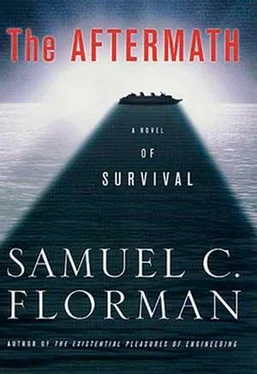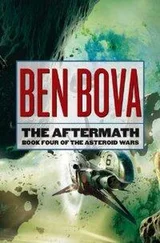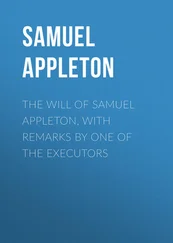Samuel Florman - The Aftermath
Здесь есть возможность читать онлайн «Samuel Florman - The Aftermath» весь текст электронной книги совершенно бесплатно (целиком полную версию без сокращений). В некоторых случаях можно слушать аудио, скачать через торрент в формате fb2 и присутствует краткое содержание. Город: New York, Год выпуска: 2001, ISBN: 2001, Издательство: Thomas Dunne books, Жанр: sf_postapocalyptic, на английском языке. Описание произведения, (предисловие) а так же отзывы посетителей доступны на портале библиотеки ЛибКат.
- Название:The Aftermath
- Автор:
- Издательство:Thomas Dunne books
- Жанр:
- Год:2001
- Город:New York
- ISBN:0-312-26652-9
- Рейтинг книги:5 / 5. Голосов: 1
-
Избранное:Добавить в избранное
- Отзывы:
-
Ваша оценка:
- 100
- 1
- 2
- 3
- 4
- 5
The Aftermath: краткое содержание, описание и аннотация
Предлагаем к чтению аннотацию, описание, краткое содержание или предисловие (зависит от того, что написал сам автор книги «The Aftermath»). Если вы не нашли необходимую информацию о книге — напишите в комментариях, мы постараемся отыскать её.
The Aftermath — читать онлайн бесплатно полную книгу (весь текст) целиком
Ниже представлен текст книги, разбитый по страницам. Система сохранения места последней прочитанной страницы, позволяет с удобством читать онлайн бесплатно книгу «The Aftermath», без необходимости каждый раз заново искать на чём Вы остановились. Поставьте закладку, и сможете в любой момент перейти на страницу, на которой закончили чтение.
Интервал:
Закладка:
Warming to his topic, Tom continued: “Uranium, which has ninety-two electrons, is the largest atom we find in nature. Any atom with more than ninety-two electrons is too large to hang together. The nucleus is unstable and the outer electrons tend to go flying off into space. Physicists, by using fancy, high-powered equipment—cyclotrons and linear accelerators—have managed to paste together another twenty-two or so elements; but such artificially made atoms break apart very quickly. So, to repeat, there are ninety-two elements which the universe gives us to use.”
“Or to leave as we find them,” Roxy muttered.
“Yes, of course,” Tom said. “But since we humans seem to be curious, comfort-seeking, and innately creative, the universe couldn’t have expected us to keep our hands to ourselves. Just think of it. All the world is made of this wonderfully organized stuff! For us engineers, it’s the most fabulous erector set one could wish for. Maybe erector set is the wrong image, since the same atoms we incorporate into manufactured objects are the basic material of burning stars and living beings. Also, they’re not material or substantial in any familiar sense. They are will-o’-the-wisp electrical ‘wavicles’—sort of waves, sort of particles—if I understand the physicists correctly. But for engineers, their orderly behavior is what counts.
“And, you know—this is what’s so incredible as we sit here on a beach with the world in ruins—it really doesn’t matter how many comets collide or how many planets are destroyed. The elements remain, and with them the capacity to reconstitute anything that has ever been, and wonders still undreamed of. Add to this the knowledge we have of what the elements are, and how they behave, and we haven’t been defeated at all. We have the makings—physical and intellectual—of a new world.”
“I thought we were talking about iron,” Herb said, with only the slightest hint of sarcasm.
“Yes, we were,” Tom said. “And we are. Among the ninety-two elements, iron with its twenty-six electrons is very, very special. When you get a reasonably pure collection of iron atoms, they arrange themselves into a nice crystalline pattern—ideal for strength—with just the right amount of internal slip—perfect for flexibility. Then, if you take iron and combine it chemically with a little bit of carbon—that is, let a few carbon atoms arrange themselves in the interstitial spaces between the iron atoms—you get the material we call steel. It’s the most useful material a tool-using, machine-making, invention-loving species could possibly want. Which means that we engineers, in discovering the secrets of iron and steel, are the makers of marvels.”
Tom Swift—calm, stoical Tom—was suddenly more animated than his friends had ever seen him. “If we’re concerned about rebuilding the world,” he said, “we should be thinking long and hard about iron. I mean, really long and really hard. What do you think that civilization is? Poems and paintings? Pretty flags and patriotic songs? No, my friends, at the heart of civilization you will find iron and steel.”
“There are other metals,” Herb said. “Why is iron so special?”
“All metals share some characteristics,” Tom responded, “but each one is unique. Believe me when I tell you that for tools, structures, and machines, iron has proved to be uniquely serviceable. Particularly when it’s mixed with a bit of carbon to make steel. And wonder of wonders, iron is plentiful. In fact, it constitutes four percent of the material in the earth’s crust. Considering its attributes and its availability—well, the whole thing is nothing short of magical.”
“Not magical,” said Mary, who had been quiet up to this point. “It’s a miracle. God’s miracle.”
“You’ve got a pretty materialistic idea about what a miracle is,” Roxy said. Her tone was critical but not unfriendly.
“That’s what happens when you mix an engineer with a believer,” Sarah said.
“Okay,” Herb pressed, allowing his curiosity to show through in spite of himself, “but how and why is this stuff so amazing?”
“First of all,” Tom said, “steel is a very hard material, by which I mean it resists penetration, it resists deformation, it resists abra sion and wear. Steel is also tough, which is different from hard: a material that is tough can absorb energy during deformation, resisting the extension of cracks. For example, in a collision, it will dent instead of shattering. In addition to being hard and tough, steel is strong, which means it can sustain heavy loads, in tension and shear, as well as in compression.
“When stressed, it will deform only slightly, elastically, returning to its original shape after the stress is removed. Yet if we stress it heavily enough—and we can calculate the forces with precision—it will deform plastically, maintaining its new shape. We can cast it, mold it, stamp it, cut it, extrude it, machine it—in so many ways fashion it to serve our needs. Hard, tough, strong, ductile; we’re talking about a uniquely utilitarian substance. And all because of the ways in which iron atoms arrange themselves when they’re together in a group.”
Flushed with excitement, raising his voice, Tom continued: “I tell you, the stuff is precious. At the same time, there’s plenty of iron in many parts of the world and limitless amounts of carbon, which means that steel is comparatively inexpensive. Which makes it all the more precious, if you get my meaning. This wonderful material is responsive to our every whim. Add more carbon and the steel becomes harder. A little less, and the steel will bend more readily while retaining its toughness. If we want a tool that is very hard on the outside, to resist abrasion, yet tough on the inside—to be able to absorb shock, for example—we simply add carbon to the outer surfaces; we call it case hardening. For other special features, we can add different materials, such as chromium to make it stainless, that is, resistant to corrosion. By using changes of temperature, we can work more miracles. Heat steel and cool it slowly—the process of annealing—the material becomes softer and more malleable, just right for molding into car body panels or cooking pots. Cool it suddenly, by quenching in liquid, and it becomes harder. And if this sudden cooling creates unwanted internal stresses, they can be relieved by reheating—that’s called tempering.”
Wil Hardy could not resist putting on his graduate student’s hat. “Of course,” he ventured, “none of the chemical reasons for this behavior were known until late in human history.”
“And you’re about to tell us exactly when that was,” Herb quipped. “Now that Tom has lectured us on chemistry, I suppose that you’re going to hold forth on the history of technology.”
“I can see that you’re tired and impatient at the moment. But, believe me, the story is worth telling. Just think of it. We’ve been thrown back into the Stone Age, six thousand years in the past, yet we intend to leap across those millennia in a flash.”
“Leapin’ lizards, History Man! Why don’t you tell the kids all about it?” Everyone laughed, but it was clear they were fascinated in spite of themselves.
“Sure. There are really two stories, one, the saga of experimentation, the centuries of trial and error during which technologists learned to smelt iron—separate it from the stone in which it is found—and combine it with carbon to make steel. The other wonderful tale is the latter-day exploits of scientists who explained the magical processes that the artisans had developed. We tend to forget that the science that we call chemistry didn’t come into being until the 1770s—three thousand years after the beginning of the so-called Iron Age. Yes, the 1770s. That’s when Antoine Lavoisier suggested, and went a long way toward showing, that all things are composed of a number of simple substances, namely, the elements, as Tom has pointed out.
Читать дальшеИнтервал:
Закладка:
Похожие книги на «The Aftermath»
Представляем Вашему вниманию похожие книги на «The Aftermath» списком для выбора. Мы отобрали схожую по названию и смыслу литературу в надежде предоставить читателям больше вариантов отыскать новые, интересные, ещё непрочитанные произведения.
Обсуждение, отзывы о книге «The Aftermath» и просто собственные мнения читателей. Оставьте ваши комментарии, напишите, что Вы думаете о произведении, его смысле или главных героях. Укажите что конкретно понравилось, а что нет, и почему Вы так считаете.












